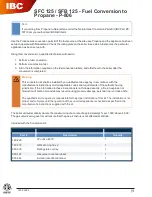
CAUTION:
RISK OF SCALDING
INCREASES WITH
HOTTER W
ATER
ENVIRON 130˚F (54˚C)
ENVIRON 120˚F (49˚C)
ENVIRON 100˚F (38˚C)
ENVIRON 85˚F (29˚C)
ENVIRON 150˚F (65˚C)
ENVIRON 45˚F (7˚C)
ENVIRON 140˚F (60˚C)
ENVIRON 160˚F (71˚C)
+5˚/-10˚
PUSH
PUSH
CAUTION:
RISK OF SCALDING
INCREASES WITH
HOTTER W
ATER
130˚F RANGE
120˚F RANGE
100˚F RANGE
85˚F RANGE
150˚F RANGE
45˚F RANGE
140˚F RANGE
160˚F RANGE
+5˚/-10˚
13
GENERAL MAINTENANCE
Draft Hood Operation
It is important to check that the ventilation system is
working properly once the water heater main burner
has been lit. Wait ten (10) minutes after lighting the
burner. Then introduce a match or candle around
the opening of the drafthood. If the flame is drawn
towards the opening, this indicates proper ventila-
tion. If the flame flutters or is blown out, combustion
gases are escaping from the drafthood opening. If
this occurs, shut the water heater off immediately and
locate the problem. Do not try and operate the water
heater again until you are satisfied that the problem has
been corrected.
Water Temperature Regulation
The higher the setting, the greater the risk of
scalding. Hot water can cause third degree burns
in one (1) second at 150˚F (65˚C), in six (6)
seconds at 140˚F (60˚C), and in thirty (30) sec-
onds at 130˚F (54˚C). In households where there
are children, physically challenged individuals, or
elderly persons, mixing valves for point of use
are necessary as means of reducing the scalding
potential of hot water.
The gas control valve is factory-adjusted to its lowest
temperature. The desired water temperature can be
selected by rotating the temperature dial on the front
of the gas control valve. Turn the temperature dial
clockwise to decrease the temperature, or coun-
terclockwise to increase the temperature. The
reference mark on the temperature dial, indicated by
a large triangle, represents 130˚F (54˚C) (see Figure
9).
Each mark to the left and right of this reference
mark indicates a temperature change of approximately
10˚F (6˚C)
When hot water is drawn from the tank in frequent
short bursts, a condition known as “stacking” is cre-
ated. “Stacking” is the result of increased cycling of the
burner and can produce very hot water temperatures at
the hot water outlet. Always remember to check the hot
water coming out of any faucet with your hand before
use. This will reduce the risk of scalding, related injury.
The gas control valve is equipped with a high limit
switch (H.L.S.). Should the temperature of the water
exceed 195˚F (90˚C), the H.L.S. will shut off the gas
to the water heater. If the H.L.S. has tripped, the gas
control valve must be replaced by a qualified service
technician.
Should overheating occur or the gas supply fail
to shut off, close the gas supply manual shut-off
valve. Failure to follow this instruction can result in
property damage, personal injury, or death.
If the water heater has been subjected to fire, flood,
or be en damaged in any way, close the gas sup-
ply manual shut-off valve. Do not operate the water
heater again until it has been inspected by a qualified
service technician.
Out of Fuel
If your water heater should run out of gas, proceed
as follows:
1) Close the gas supply manual shut-off valve.
2) Depress slightly and turn the gas control knob
clockwise to the “OFF” position.
3) Once the gas supply has been re-established,
proceed to the Lighting Instructions.
WARNING
DANGER
WARNING
DANGER
Figure 9






































